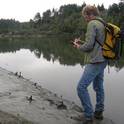
Anthropologists recognize the economic importance of fishing weirs in the harvest of marine resources by Northwest Coast peoples. Yet very little research has focused on the range of variability in weir technology and its cultural and environmental context. I examine intertidal fishing technologies on the Oregon Coast, a southerly portion of the Northwest Coast. On the Oregon Coast, the estuary ecotone held a great abundance and diversity of fishes. The largest and most numerous Native residential centers were located along the shores of estuaries, and tidewater fishing appears to have been central to the region’s economy.
I examine extensive unpublished archival accounts of Native oral history relating to Tidewater weir technology. I also present the results of archaeological survey, radiocarbon dating, feature characterization, and ecological and taphonomic studies. This archaeological research fills a large gap; 10 years ago only 6 of the 72 archaeological weir sites reported here had been recorded and none of the 81 radiocarbon (14C) dates from weir stakes and lattice had been acquired. Over 80 percent of the 14C dates from wood stakes date to the last millennium, with earlier dates distributed evenly over the period between about 3400 and 1000 years ago.
Using of the new data on tidewater weir fishing, I address some of the economic aspects of theories that relate weir use to the development of social ranking and wealth differentiation on the Northwest Coast. I find that several prevailing assumptions about weir technology and its cultural context are unfounded. In many ways tidal weir fishing has been portrayed as involving large group organization, annual rebuilding, short-term intensive harvest, and processing for long-term storage, characteristics thought to be related to the development of hierarchical social organization. Yet fishing structures used in Oregon Coast estuaries were very different from the large fish dams used in rivers above tidewater. Where riverine weirs were often built and used only for seasonal use, tidal weirs were used throughout the year to harvest a diversity of marine fishes such as herring, sardine, smelt, and salmon, fishes that collectively entered estuaries in large numbers during all seasons.
I argue that researchers investigating tidal weir use should consider the full range of subsistence activities possible with these structures. Furthermore, models relating social developments to weir fishing should be revised in light of new data on the temporal, geographic, and residential context of weir fishing.
- fishing weirs,
- fish traps,
- wet sites,
- Coquille,
- Yaquina,
- Siuslaw,
- Coos,
- Oregon coast
Available at: http://works.bepress.com/byram/5/
